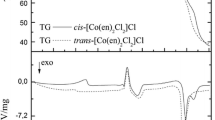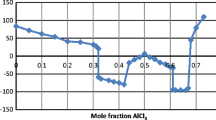Abstract
Two novel imidazolium based ether-functionalized room temperature ionic liquids were synthesized to study the temperature dependence of the isobaric heat capacity in the temperature range 298.15–348.15 K. In-house synthesized ionic liquids are often available in small amounts only, owing to the high cost of the precursors and difficulties during the synthesis itself. It is therefore impossible to repeat measurement many times so that a statistically significant data sample can be obtained. In addition, to obtain at least several values of the measured property, the ionic liquid must be recycled and reused. In this work two recycling techniques were used and their influence on the values of the experimental isobaric heat capacity was analyzed. Advantages of a modern nonstatistical data analysis technique, namely mathematical gnostics, were demonstrated.






Similar content being viewed by others
Notes
Being confused by computer terminology we often speak about real numbers but irrational numbers such as \(\pi \) or \(\sqrt{2}\) are never used as measured values of physical quantities.
Digital equipment is cheap nowadays and adding a few additional bits to an A/D converter is not a problem, yet we have observed distribution functions that might signal this effect in our data. However, we do not have a strong evidence that it is really caused by insufficient resolution. In any case such a distribution function is far from usual behavior known in statistics.
The necessary minimum size is three distinct values, otherwise the equations cannot be solved. It is recommended to have at least four values.
Other types of distribution functions are also available but they are not important for our applications.
References
Wasserscheid, P., Welton, T. (eds.): Ionic Liquids in Synthesis, 2nd edn. Wiley-VCH, Weinheim (2008)
Kirchner, B. (ed.): Ionic Liquids, Topics in Current Chemistry, vol. 290. Springer, Berlin (2010). doi: 10.1007/978-3-642-01780-3
Aparicio, S., Atilhan, M., Karadas, F.: Thermophysical properties of pure ionic liquids: review of present situation. Ind. Eng. Chem. Res. 49, 9580–9595 (2010). doi:10.1021/ie101441s
Andresova, A., Storch, J., Traïkia, M., Wagner, Z., Bendova, M., Husson, P.: Branched and cyclic alkyl groups in imidazolium-based ionic liquids: molecular organization and physico-chemical properties. Fluid Phase Equilib. 371, 41–49 (2014)
Srour, H., Traïkia, M., Fenet, B., Rouault, H., Costa Gomes, M.F., Santini, C.C., Husson, P.: Effect of nitrile-functionalization of imidazolium-based ionic liquids on their transport properties, both pure and mixed with lithium salts. J. Solution Chem. 1, 1–16 (2014). doi:10.1007/s10953-014-0280-2
Monteiro, M.J., Camilo, F.F., Ribeiro, M.C.C., Torresi, R.M.: Ether-bond-containing ionic liquids and the relevance of the ether bond position to transport properties. J. Phys. Chem. B 114, 12488–12494 (2010). doi:10.1021/jp104419k
Zhang, J., Fang, S., Qu, L., Jin, Y., Yang, L., Hirano, SI: Synthesis, characterization, and properties of ether-functionalized 1,3-dialkylimidazolium ionic liquids. Ind. Eng. Chem. Res. 53, 16633–16643 (2014)
Chen, Z.J., Xue, T., Lee, J.M.: What causes the low viscosity of ether-functionalized ionic liquids? Its dependence on the increase of free volume. RSC Adv. 2, 10564–10574 (2012). doi:10.1039/c2ra21772d
Galiński, M., Lewandowski, A., Stpniak, I.: Ionic liquids as electrolytes. Electrochim. Acta 51, 5567–5580 (2006). doi:10.1016/j.electacta.2006.03.016
Verma, P.L., Bartolotti, L.J., Gejji, S.P.: Probing molecular interactions in functionalized asymmetric quaternary ammonium-based dicationic ionic liquids. J. Phys. Chem. A 120, 7732–7744 (2016). doi:10.1021/acs.jpca.6b07337
Kärnä, M., Lahtinen, M., Hakkarainen, P.L., Valkonen, J.: Physicochemical properties of new dicationic ether-functionalized low melting point ammonium salts. Aust. J. Chem. 63, 1122–1137 (2010)
Kärnä, M., Lahtinen, M., Valkonen, J.: Preparation and characterization of new low melting ammonium-based ionic liquids with ether functionality. J. Mol. Struct. 922, 64–76 (2009). doi:10.1016/j.molstruc.2009.01.041
Kovanic, P., Humber, M.B.: The Economics of Information (Mathematical Gnostics for Data Analysis). http://www.math-gnostics.eu/books/ (2015)
Taylor, B.N., Kuyatt, C.E.: Guidelines for evaluating and expressing the uncertainty of NIST measurement results. NIST Technical Note 1297 (1994)
Box, G.: Robustness in Statistics, chap. Robustness in the strategy of scientific model building, p. 202. Academic Press, Cambridge (1979)
Kondepudi, D., Prigogine, I.: Modern Thermodynamics. From Heat Engines to Dissipative Structures, chap. 14.2. Wiley, Chichester (2002)
Chirico, R.D., Frenkel, M., Magee, J.W., Diky, V., Muzny, C.D., Kazakov, A.F., Kroenlein, K., Abdulagatov, I., Hardin, G.R., Acree Jr., W.E., Brenneke, J.F., Brown, P.L., Cummings, P.T., de Loos, T.W., Friend, D.G., Goodwin, A.R.H., Hansen, L.D., Haynes, W.M., Koga, N., Mandelis, A., Marsh, K.N., Mathias, P.M., McCabe, C., O’Connell, J.P., Padua, A., Rives, V., Schick, C., Trusler, J.P.M., Vyazovkin, S., Weir, R.D., Wu, J.: Improvement of quality in publication of experimental thermophysical property data: challenges, assessment tools, global implementation, and online support. J. Chem. Eng. Data. 58, 2699–2716 (2013). doi:10.1021/je400569s
Víšek, J.A.: www.math-gnostics.eu
Wagner, Z., Kovanic, P.: Advanced data analysis for industrial applications. Conference Modelling Smart Grids, Prague (2015). doi:10.13140/RG.2.1.3073.8808. [cit 2016-19-05]
NIST WebBook Chemistry. http://webbook.nist.gov/cgi/cbook.cgi?ID=110-56-5&Units=SI&cTP=on
NIST WebBook Chemistry.http://webbook.nist.gov/cgi/cbook.cgi?ID=67-66-3&Units=SI&cTP=on
Zábranský, M., Kolská, Z., Růžička, V., Domalski, E.S.: Heat capacity of liquids: critical review and recommended values. Supplement II. J. Phys. Chem. Ref. Data 39, 013103 (2010)
Machanová, K., Wagner, Z., Andresová, A., Rotrekl, J., Boisset, A., Jacquemin, J., Bendová, M.: Thermal properties of alkyl-triethylamonium bis(trifluoromethyl)sulfonylimide ionic liquids. J. Solution Chem. 44, 790–810 (2015). doi:10.1007/s10953-015-0323-3
Stark, A., Behrend, P., Braun, O., Muller, A., Ranke, J., Ondruschka, B., Jastorff, B.: Purity specification methods for ionic liquids. Green Chem. 10, 1152–1161 (2008). doi:10.1039/b808532c
Acknowledgements
Partial financial support of Ministry of Education, Youth, and Sports Grant LD14090 acknowledged. The authors also thank Ms. Irena Benešová Ševčíková for carrying out the ion chromatography measurements.
Author information
Authors and Affiliations
Corresponding author
Rights and permissions
About this article
Cite this article
Wagner, Z., Bendová, M., Rotrekl, J. et al. Advanced Analysis of Isobaric Heat Capacities by Mathematical Gnostics. J Solution Chem 46, 1836–1853 (2017). https://doi.org/10.1007/s10953-017-0676-x
Received:
Accepted:
Published:
Issue Date:
DOI: https://doi.org/10.1007/s10953-017-0676-x




